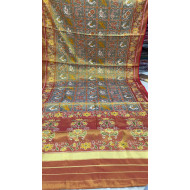
Patan, a historic city in the Indian state of Gujarat, is renowned for its exquisite Patola silk sarees. These sarees are celebrated for their intricate designs, vibrant colors, and the meticulous craftsmanship involved in their creation. The art of Patola weaving, also known as double ikat weaving, is a heritage craft that has been passed down through generations. Let's delve into the fascinating process of Patan's Patola weaving.
The History and Legacy
Patola sarees have a rich history that dates back to the 11th century. These sarees were once the attire of royal and aristocratic families. The Salvi family, traditionally known for their weaving skills, has been at the forefront of preserving this age-old craft. Despite the labor-intensive process and the decline in the number of skilled artisans, the Salvi family continues to uphold the legacy of Patola weaving.
The Intricate Process of Patola Weaving
The creation of a Patola saree is an elaborate and time-consuming process that can take anywhere from six months to a year to complete. Here’s a step-by-step overview of how these masterpieces are crafted:
1. Selecting the Silk
The process begins with selecting the finest quality silk threads. Traditionally, Chinese or locally sourced mulberry silk is used. The threads are then carefully cleaned and prepared for dyeing.
2. Designing the Pattern
The intricate patterns and motifs are meticulously planned. Traditional designs often include geometrical shapes, floral patterns, and depictions of animals and birds. These patterns are sketched out and then transferred onto graph paper.
3. Dyeing the Threads
The most distinctive feature of Patola weaving is the dyeing process. Both the warp (lengthwise threads) and the weft (crosswise threads) are tie-dyed before weaving. This process, known as double ikat, involves tying the threads at specific intervals and then dyeing them. The tied sections resist the dye, creating intricate patterns when the threads are woven together. The dyeing process is repeated multiple times to achieve the desired colors and patterns.
4. Preparing the Loom
Once the threads are dyed, they are carefully aligned on a traditional handloom. This alignment is crucial as even a minor error can distort the pattern. The loom is set up with precision to ensure that the threads intersect at the correct points to recreate the pre-determined design.
5. Weaving the Saree
The actual weaving of a Patola saree is an incredibly delicate task. Skilled weavers work with great concentration, ensuring that each thread is placed correctly. The double ikat technique ensures that the pattern appears identical on both sides of the fabric, a hallmark of authentic Patola sarees.
6. Finishing Touches
After the weaving is complete, the saree undergoes several finishing processes. It is washed, starched, and ironed to enhance its texture and sheen. The final product is a vibrant, durable, and intricately patterned saree that embodies the rich cultural heritage of Patan.
Challenges and the Future
Despite its beauty and historical significance, Patola weaving faces several challenges. The painstaking process and the decline in the number of skilled artisans have made these sarees rare and expensive. However, there is a renewed interest in this art form, with efforts being made to promote and preserve it.
The Salvi family, along with various governmental and non-governmental organizations, is working towards training new artisans and creating awareness about Patola weaving. With the right support, this timeless craft can continue to thrive and enchant future generations.
Conclusion
Patan's Patola sarees are not just garments; they are works of art that tell a story of tradition, craftsmanship, and cultural heritage. Each saree is a testament to the skill and dedication of the weavers who pour their heart and soul into creating these masterpieces. As we celebrate the beauty of Patola sarees, let us also recognize and support the artisans who keep this incredible tradition alive.
Discover More
To truly appreciate the artistry of Patola weaving, consider visiting Patan and witnessing the process firsthand. You can also support this heritage craft by purchasing authentic Patola sarees and spreading awareness about the importance of preserving traditional arts.
Patan's Patola weaving is a testament to the rich cultural tapestry of India. Its intricate designs and vibrant colors continue to captivate admirers around the world, ensuring that this ancient craft remains a cherished part of our heritage.








3 Comment(s)
Kinguin bietet fantastische Aktionen und Deals auf eine breite Auswahl an Spielen und Software!
Don’t worry about how you’ll get your junk car to a scrapyard. Cash for cars companies offer free towing, so you don’t have to worry about hiring a tow truck or paying for transport. They’ll pick up your vehicle wherever it’s located and pay you cash when they take it away.
Cool!
Leave a Comment